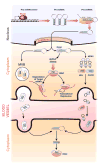Circulating Micro-RNAs as Diagnostic Biomarkers for Endometriosis: Privation and Promise
- PMID: 25757811
- PMCID: PMC4489990
- DOI: 10.1016/j.jmig.2015.02.021
Circulating Micro-RNAs as Diagnostic Biomarkers for Endometriosis: Privation and Promise
Abstract
Endometriosis represents a major medical concern in women of reproductive age. One of the remaining major hurdles for successful treatment of endometriosis is the limitation of the process of timely disease diagnosis. A simple blood test for endometriosis-specific biomarkers would offer a more timely accurate diagnosis for the disease, thus allowing for earlier treatment intervention. Although there have been considerable efforts to identify such biomarkers, no clear choice for such noninvasive diagnostic tools has been identified. Micro-RNAs are small noncoding RNAs that have been evaluated intensively as biomarkers for several diseases, and they may hold promise for a diagnosis of endometriosis. In this review, we highlight the need for noninvasive testing for endometriosis, discuss the potential use of micro-RNAs as diagnostic tools for this disease, and consider potential limitations in the use of these small RNA molecules as diagnostic markers for endometriosis.
Keywords: Diagnostic biomarker; Endometriosis; microRNA.
Copyright © 2015 AAGL. Published by Elsevier Inc. All rights reserved.
Figures

Similar articles
-
Circulating microRNAs identified in a genome-wide serum microRNA expression analysis as noninvasive biomarkers for endometriosis.J Clin Endocrinol Metab. 2013 Jan;98(1):281-9. doi: 10.1210/jc.2012-2415. Epub 2012 Nov 1. J Clin Endocrinol Metab. 2013. PMID: 23118427
-
Preoperative assessment and diagnosis of endometriosis: are we any closer?Curr Opin Obstet Gynecol. 2015 Aug;27(4):284-90. doi: 10.1097/GCO.0000000000000188. Curr Opin Obstet Gynecol. 2015. PMID: 26125979 Review.
-
MicroRNAs in endometriosis: biological function and emerging biomarker candidates†.Biol Reprod. 2019 May 1;100(5):1135-1146. doi: 10.1093/biolre/ioz014. Biol Reprod. 2019. PMID: 30721951 Free PMC article. Review.
-
Analysis of Serum microRNA Profile by Solexa Sequencing in Women With Endometriosis.Reprod Sci. 2016 Oct;23(10):1359-70. doi: 10.1177/1933719116641761. Epub 2016 Jul 13. Reprod Sci. 2016. PMID: 27412772
-
Diagnostic Value of Circulating MicroRNAs for Endometriosis: a Meta-analysis.Reprod Sci. 2020 Mar;27(3):793-805. doi: 10.1007/s43032-019-00024-5. Epub 2020 Feb 24. Reprod Sci. 2020. PMID: 32096023
Cited by
-
MicroRNAs in Endometriosis: Insights into Inflammation and Progesterone Resistance.Int J Mol Sci. 2023 Oct 9;24(19):15001. doi: 10.3390/ijms241915001. Int J Mol Sci. 2023. PMID: 37834449 Free PMC article. Review.
-
Altered Differential Expression of Genes and microRNAs Related to Adhesion and Apoptosis Pathways in Patients with Different Phenotypes of Endometriosis.Int J Mol Sci. 2023 Feb 23;24(5):4434. doi: 10.3390/ijms24054434. Int J Mol Sci. 2023. PMID: 36901866 Free PMC article.
-
Diagnostic Value and Molecular Function of MicroRNAs in Endometrial Diseases: A Systematic Review.Cancers (Basel). 2024 Jun 30;16(13):2416. doi: 10.3390/cancers16132416. Cancers (Basel). 2024. PMID: 39001478 Free PMC article. Review.
-
mir-320b rs755613466 T>C and mir-27a rs780199251 G>A polymorphisms and the risk of IVF failure in Kurdish women.Mol Biol Rep. 2020 Mar;47(3):1751-1758. doi: 10.1007/s11033-020-05266-0. Epub 2020 Jan 31. Mol Biol Rep. 2020. PMID: 32006196
-
Serum miR-451a Levels Are Significantly Elevated in Women With Endometriosis and Recapitulated in Baboons ( Papio anubis) With Experimentally-Induced Disease.Reprod Sci. 2017 Aug;24(8):1195-1202. doi: 10.1177/1933719116681519. Epub 2016 Dec 5. Reprod Sci. 2017. PMID: 27920341 Free PMC article.
References
-
- Berkley KJ, Stratton P. Mechanisms: lessons from translational studies of endometriosis. In: Gimberardion MA, editor. Visceral Pain: Clinical, Pathophysiological and Therapeutic Aspects. Oxford: Oxford University Press; 2009. pp. 39–50.
-
- Eskenazi B, Warner ML. Epidemiology of endometriosis. Obstet Gynecol Clin North Am. 1997;24:235–58. - PubMed
-
- Giudice LC, Kao LC. Endometriosis. Lancet. 2004;364:1789–99. - PubMed
-
- Berube S, Marcoux S, Maheux R. Characteristics related to the prevalence of minimal or mild endometriosis in infertile women. Canadian Collaborative Group on Endometriosis. Epidemiology. 1998;9:504–10. - PubMed
Publication types
MeSH terms
Substances
Grants and funding
LinkOut - more resources
Full Text Sources
Other Literature Sources
Medical

